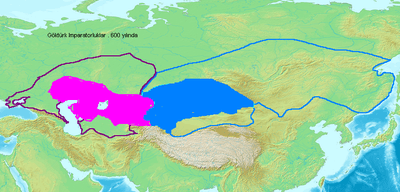Göktürk civil war

The Göktürk civil war (or Turkic interregnum) was an important crisis in Central Asia during the 580s, which resulted in the split of the Göktürk Khaganate and the creation of separate western and eastern khaganates.
Background
The Turkic Khaganate or Göktürks, was an empire stretching between the Chinese Empire and the Black Sea. The name of the ruling dynasty was Ashina. The khagans were appointed by the kurultay (council of tribe leaders), normally from the sons, brothers of nephews of the last ruler.
Beginning of the interregnum
In 581, the fourth khagan Taspar Qaghan died. There were four claimants to throne. The personal and regnal names are shown below:
| father, grandfather |
Regnal name
(Chinese reading) |
Personal name
(Chinese reading) |
Regnal name | Personal name | |
|---|---|---|---|---|---|
| Prince Anlo | Taspar,Bumin | Di-er ke-han | An-luo | NA | Амрак (Amrak) |
| Apa Qaghan | Muqan,Bumin | A-po K'o-han | Ta-lo-pien | Апа-хан (Apa-khan) | Торэмен (Töremen) |
| Ishbara Qaghan | Issik,Bumin | Sha-po-lüeh K'o-han, | She-t'u | Бага Ышбара-хан (Bağa Işbara-han) | Иль-кюлюг шад (İl-külüg şad) |
| Tardu | Bumin's brother | Ta-t'ou K'o-han | Tien-chüeh | Тардуш-хан, Боке-хан (Tardu-khan, Böke-khan) | Кара-Чурин Тюрк (Kara-Çürin Türk) |
Bumin founded the dynasty and was followed in succession by his three sons: Issik, Muqan and Taspar. Prince Anlo was Taspar Qaghan's son, Talopien (Apa Qaghan) and Shetu (Ishbara Qaghan) were Taspar's nephews, while Tien-chueh (Tardu) was Taspar's cousin. (see Göktürk family tree)
Before dying, Taspar Qaghan had announced his preference for Apa Qaghan (then called Talopien) to succeed him instead of his son Anlo, although he had no right to determine the succession. During the kurultay after Taspar's death, Ishbara (then called Shetu), who was also a claimant, saw that he had no chance and supported the pacifist Anlo against Apa on the ground that Apa's mother was not of noble birth.[2] He threatened the kurultay that in case of Apa's election he would revolt. Thus the kurultay appointed Anlo as the new khan. However Anlo's regency was short-lived because of the reaction of Apa's partisans. Anlo quickly renounced the title on behalf of his powerful ally Shetu (Ishbara) who became the khan with the regnal name Ishbara Qaghan.[2]
Partition
Ishbara Qaghan held the center, residing in the holy forest Ötüken in central Mongolia. Tardush held the far west in what was becoming the Western Turkic Khaganate. The third khagan was Anlo, who controlled the region around the Tuul River near Ulan Bator. Apa Qaghan, was sovereign in the northern territories.[3]
Civil war
In 584, Ishbara Qaghan raided Apa Qaghan's territory and killed the Apa Qaghan's mother. Apa Qaghan took refuge in the west and allied himself with its powerful ruler Tardu. Both Tardu and his brother Tamgan (Turksanf), the ruler of the Volga river area, supplied him with troops. Ishbara Qaghan wasn't able to compete with this force, and accepted the suzerainty of Sui China to protect himself. With Chinese support he was able to capture Apa Khagan's family members. Apa Qaghan once again escaped west and settled in the Paykend near Bukhara (in modern Uzbekistan). However, in his new territory, the former alliance broke and he lost the support of Tardu because of the disagreement over the control of the Silk Road. In 587, both Ishbara Qaghan and Apa Qaghan died.
Aftermath
After Ishbara and Apa died the east was held by Ishbara's brother Bagha Qaghan (587-89) and Ishbara's son Tulan Qaghan (589-99), while the west remained under Tardush (587-603). After Tulan's death Tardush briefly reunified east and west, but after 603 the two halves were definitely separated.
See also
References
- 1 2 Turkic reading in the onomastic table of Ancient Turks by Lev Gumilev, Лев Николаевич Гумилёв, «Древние тюрки», 1967 г, С. 463-469, Ономастическая таблица. (in Russian)
- 1 2 Book of Sui, Vol. 84
- ↑ Lev Nikolayrviç Gumilev: Eski Türkler (trans. D.Ahsen Batur) Selenge yayınları, İstanbul, 2002 ISBN 975-7856-39-8 p. 140